My Machu Picchu holiday
It had been a lifetime dream for me: to trek to Machu Picchu along the Inca Trail in Peru. Now, for the last four days, I had been hiking through stunning Peruvian mountains to reach my destination, the famous UNESCO World Heritage site of Machu Picchu itself.
But sitting on the ground under a make-shift bus shelter in the dark at 3am waiting to be allowed onto the final stage of the trek, I found that I really didn’t want the journey to end. It had been such an amazing, challenging and memorable experience just to get to this point, that reaching my goal was going to be surprisingly bitter sweet.
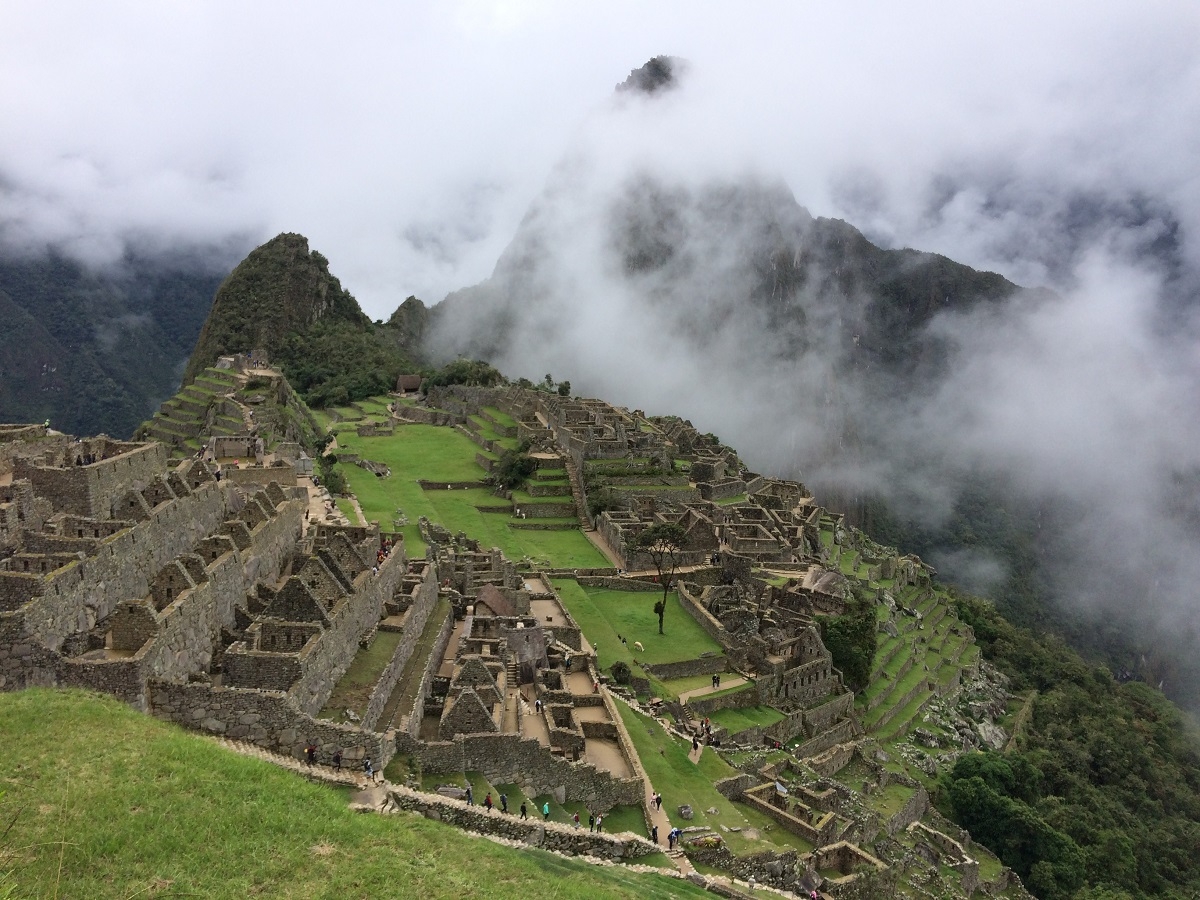
The World Heritage site of Machu Picchu was my destination – but did I really want to get there after all?
Machu Picchu tour with G Adventures
When I was initially contemplating this trip, I had thought of little else than seeing Machu Picchu, the 15th century Inca site high in the Andes which had remained lost in the Peruvian forests until just 100 years ago, and hadn’t really paid a great deal of attention to how I was going to get there.
This meant that I was in a for a bit of a shock when I was sitting in a classroom in the bustling town of Cusco in Peru, our meeting point at the start of the journey.
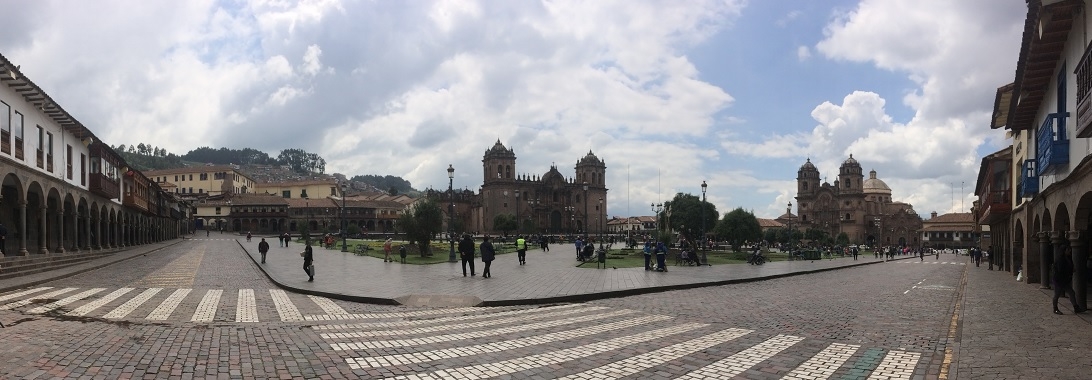
Cusco’s huge main square, the impressive Plaza de Armas, which contains Cusco Cathedral and and the church Iglesia de la Compania de Jesus
Travelling with G Adventures
I was travelling in a group of 11 other people with adventure tour operator G Adventures and our enthusiastic guide Elias was talking us through each day. Rather than taking first a train and then a bus to Machu Picchu like most tourists do, we were lucky enough – as only 500 people are allowed on it each day – to trek the Inca Trail, 25 miles (for us) of ancient footpath through the Andes and along the Amazonian basin which leads to Machu Picchu.
I had only the vaguest idea of what trekking the Inca Trail would involve (you could say that I’d skimped on the research, but I do like to arrive on these trips with as few preconceptions as possible), and I’d rather blithely assumed it would be a gentle walk through the Peruvian countryside.
A slide showing the second day’s walking popped up on the screen – a diagonal line going from the bottom left to the top right in a sheer climb. ‘Total elevation 1,115 metres,’ it said, adding, more alarmingly: ‘Highest point: Dead Woman’s Pass.’ This did not sound good.
‘We’re going to climb that high in just one day?’ gasped one of my fellow travellers. ‘Don’t worry, it’ll be fine,’ said Elias reassuringly. ‘When you’ve finished walking, then you can have lunch.’
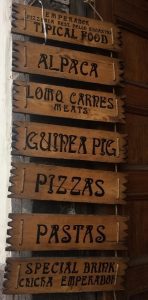
The menu at one of the many restaurants in Cusco, Peru
Not everyone looked convinced by this, but there was no backing out now (apart from one girl in our group who had been bitten the previous day by a dog in Lima – she had to return to the US for her rabies shots).
That evening I wandered around Cusco – slowly, as I was well aware that, at 3,399 metres, I was far above my usual altitude and having flown in just that morning, wasn’t really giving myself any time to acclimatise. After a low-key meal of pizza (I decided against hamster, which was also on the menu, pictured right) before an early night.
Leaving Cusco
The next morning we left our hotel at 7am – which would turn out to be one of the later starts of the week – carrying day rucksacks and larger, identical duffle bags. These were the bags that the porters were going to be carrying for us on the Inca Trail and were limited to a strict 6kg weight.
After a sleeping bag and mat, this didn’t leave much room for anything else except a handful of spare clothes, so I decided to leave all toiletries (except for absolutely crucial hand sanitiser/anti-bac wipes) behind in my luggage which stayed back at the hotel, and not wash for four days. Thankfully everyone else had reached the same conclusion and we would be unwashed together.
Check out these amazing adventure holidays
An Arctic adventure in Svalbard
Setting sail on the ‘world’s most beautiful sea voyage’
My epic food tour of Japan: sushi, sake and bullet trains
Zip-lining, rafting and cliff-diving: my perfect Jamaica holiday
Sailing to Antarctica on a 15-day cruise of the Seventh Continent
Exploring Sacred Valley
Rather than risking altitude sickness by charging straight into the Inca Trail which reaches 4,215m above sea-level – some of the group had been travelling around central and South America but others, like me, had just flown in, from London, Canada, the US and Australia – we had a day experiencing a bit more of Peru.
Driving through the lush greenery of the Sacred Valley, our first stop was Cristo Blanc, an 8m-high statue of Christ overlooking Cusco.
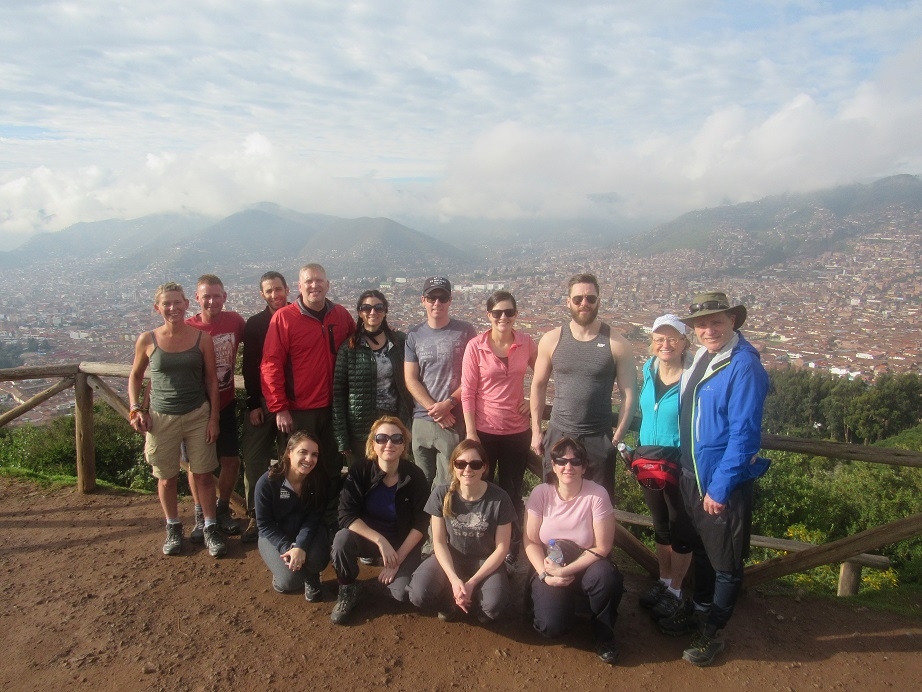
Our G Adventures gang having the first of many photo ops, this one at the statue of Christ overlooking the town of Cusco
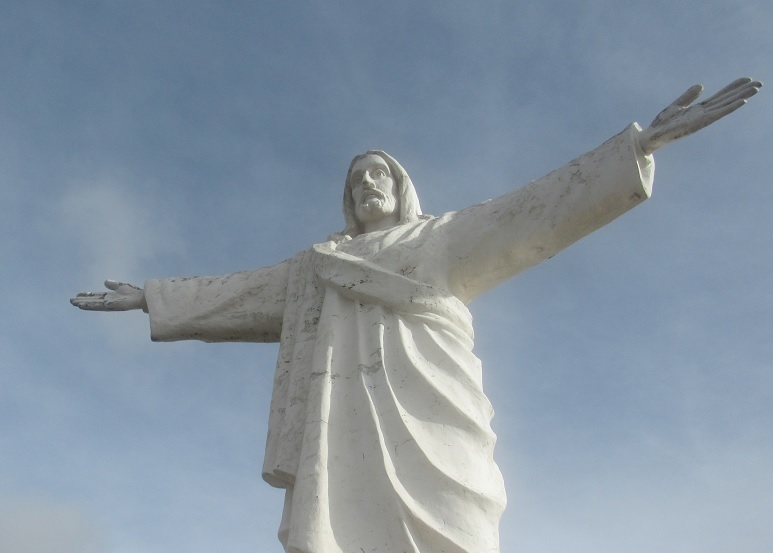
Like a mini version of the Christ the Redeemer statue overlooking Rio, this 8 metre statue of Christ overlooks the sprawling Peruvian town of Cusco
After stopping off for a quick snack of guinea pig, roasted whole on a massive wooden stake and considered a real treat by Peruvians who serve it at weddings and family dinners, we then visited rural villages where the locals still made crafts by hand using traditional materials – llama hair for hats and scarves, dyed with local plants or the cochineal beetle, and clay pots made from local earth.
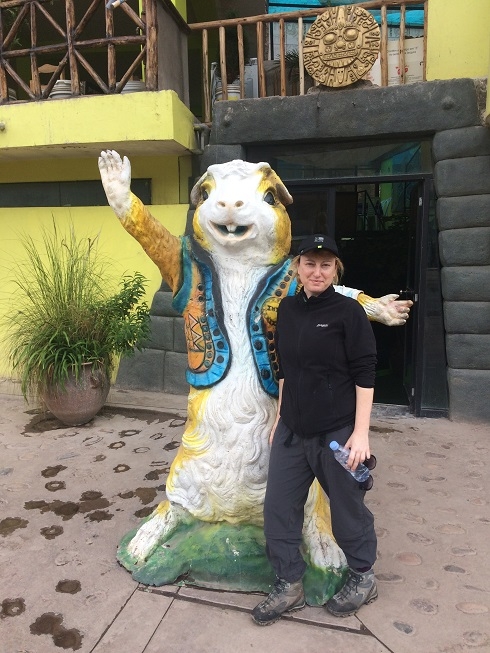
He wouldn’t be so friendly if he’d known I’d just eaten one of his friends… guinea-pig is a local delicacy in Peru, eaten at special occasions, and we passed many street stalls where they were cooked roasted on wooden stakes
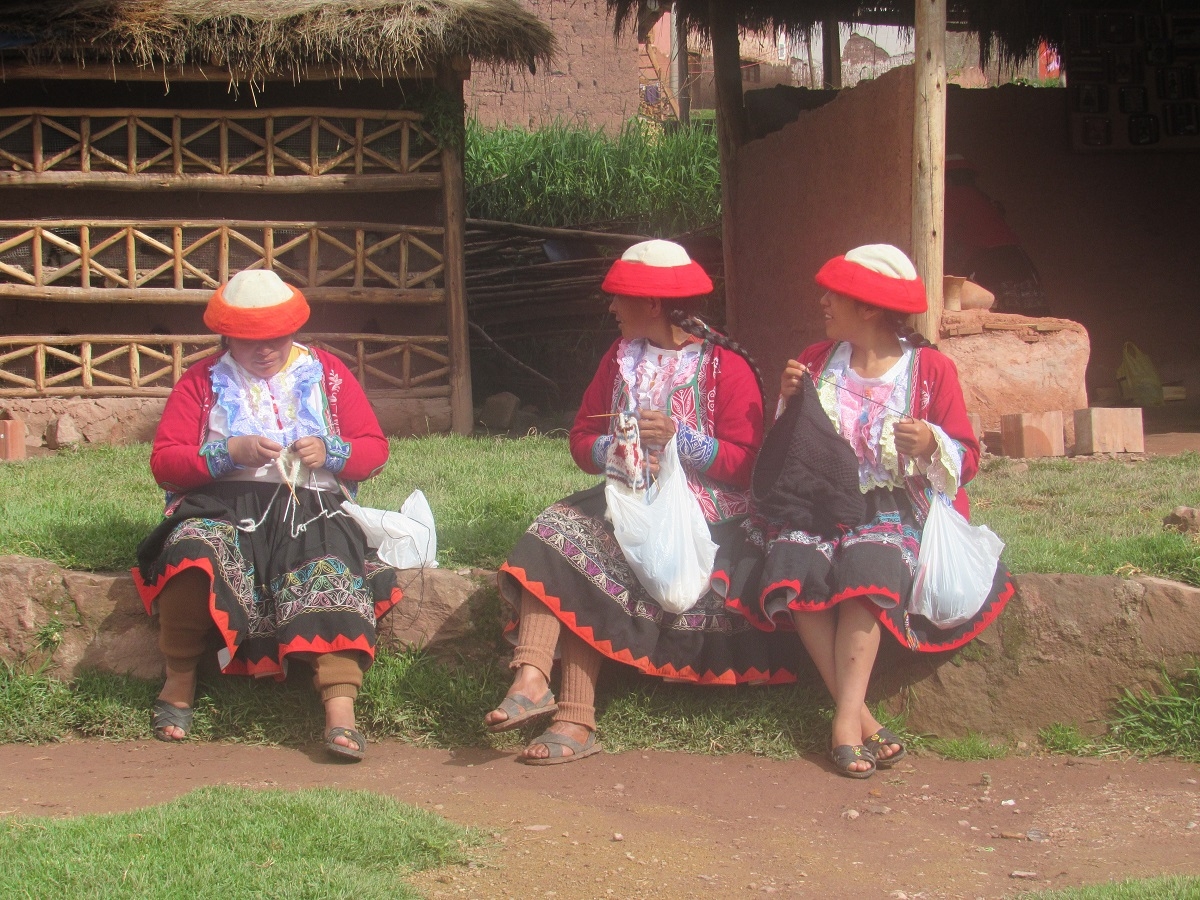
As part of our trip, we visited several local communities where the women dressed in traditional clothes and made clothes and pots out of llama and alpaca wool, colouring them with natural plant and insect dyes
Getting to Ollantaytambo
As we travelled further south, the scenery started to become more dramatic, with the hills turning into mountains and then we arrived at Ollantaytambo, the main starting point for the Inca Trail and an historic site in itself, constructed by the Incas and still with traditional cobbled streets and Inca-built buildings to explore.
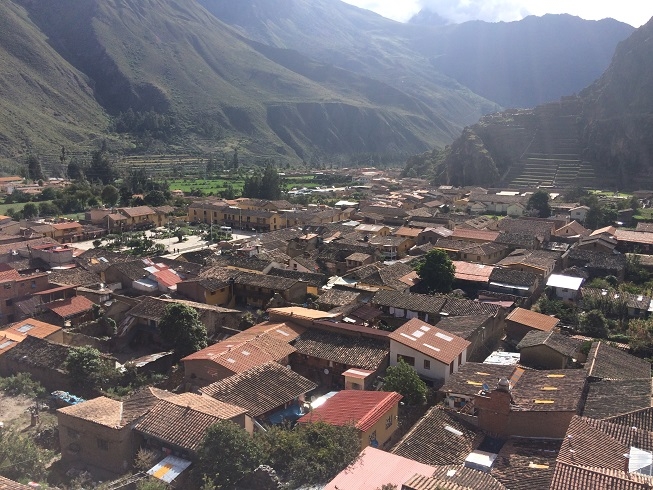
The historic town of Ollantaytambo, in the Sacred Valley of the Incas, was inhabited by the Incas in the 15th century and is surrounded by Inca sites and spectacular mountains
After spending several hours in the minibus, we were keen to get moving but Elias warned us against doing anything but super-casual walking. ‘You don’t want to come all this way to trek the Inca Trail and then twist an ankle the night before,’ he cautioned (and indeed I have since met several people who did just that and had their trip ruined).
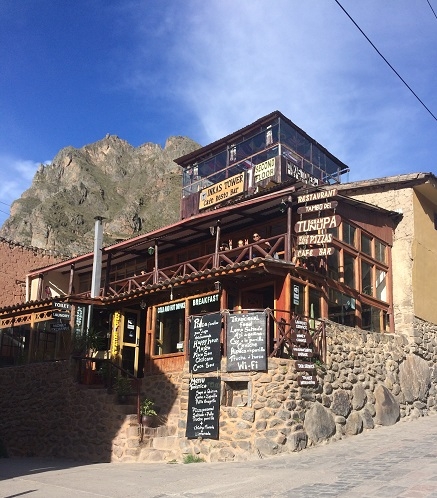
We avoided too much strenuous exercise by ambling around the very pleasant town of Ollantaytambo instead and checking out some of its many bars and restaurants
We had a very relaxed amble to a look-out point over town and then restrained ourselves to sampling some Pisco Sours and a meal of chicken and rice before having an early night.
Start of the Inca Trail
The next morning it was time to stop preparing and actually start doing the real thing, and we couldn’t have asked for a more epic start to the Inca Trail – a swaying suspension bridge crossing the turbulent waters of the Urubamba river, while the train whistled along the nearby track on the opposite shore.
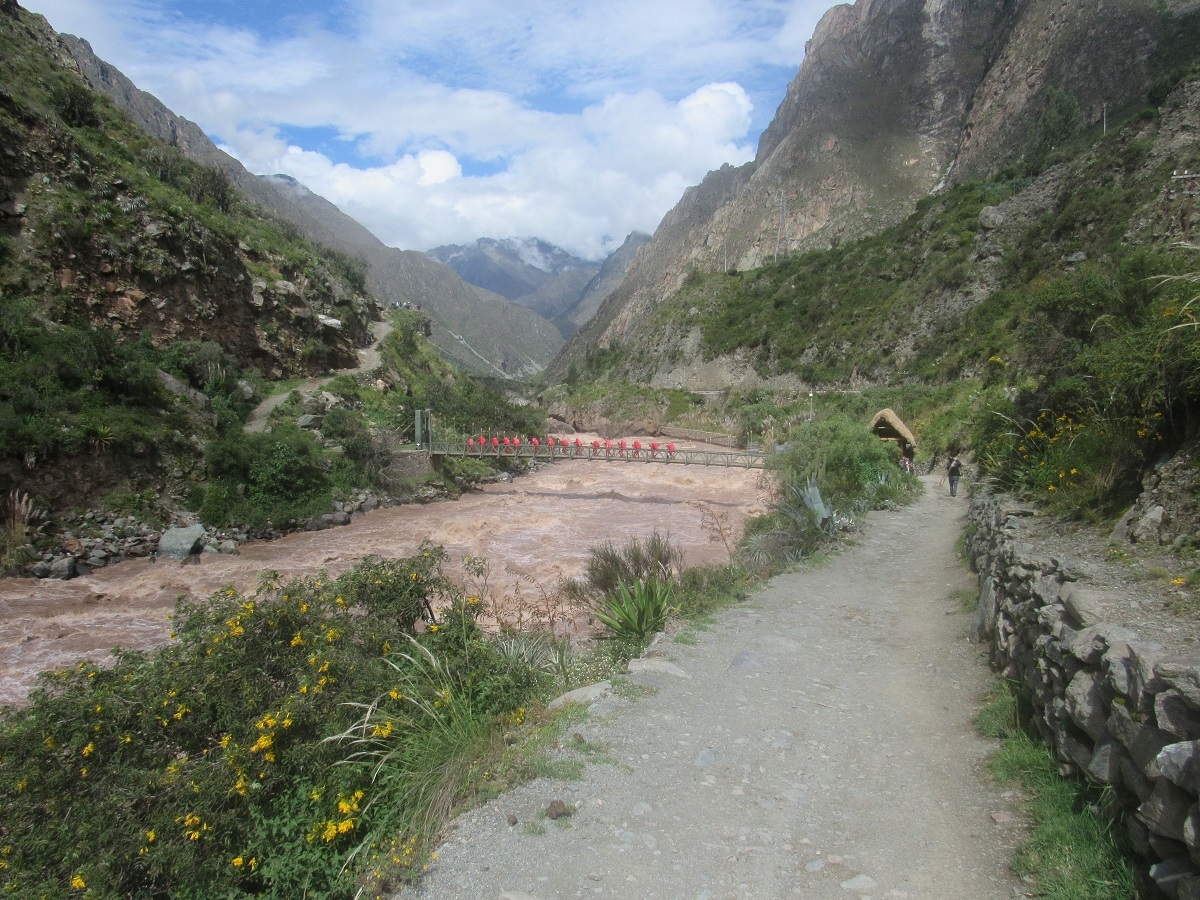
The path to the start of the Inca Trail runs parallel to a gushing, turbulent river and flanked by sheer mountains on either side
It had been a short drive by minibus to a car park by the start where we handed our duffle bags over to our guides (it was here the bags were weighed and sent back if they were too heavy) and then a final loo visit and photo call before heading down the road, rucksacks on our backs, to the checkpoint.
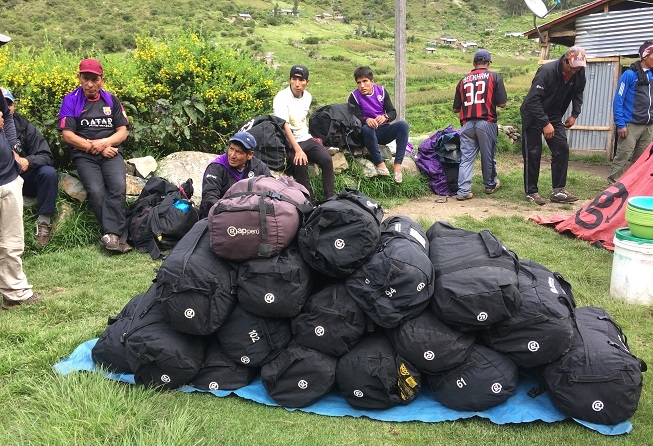
Our pile of black duffle bags which were to be carried by our team of porters and contained sleeping bags, mats and spare clothes (and not much else)
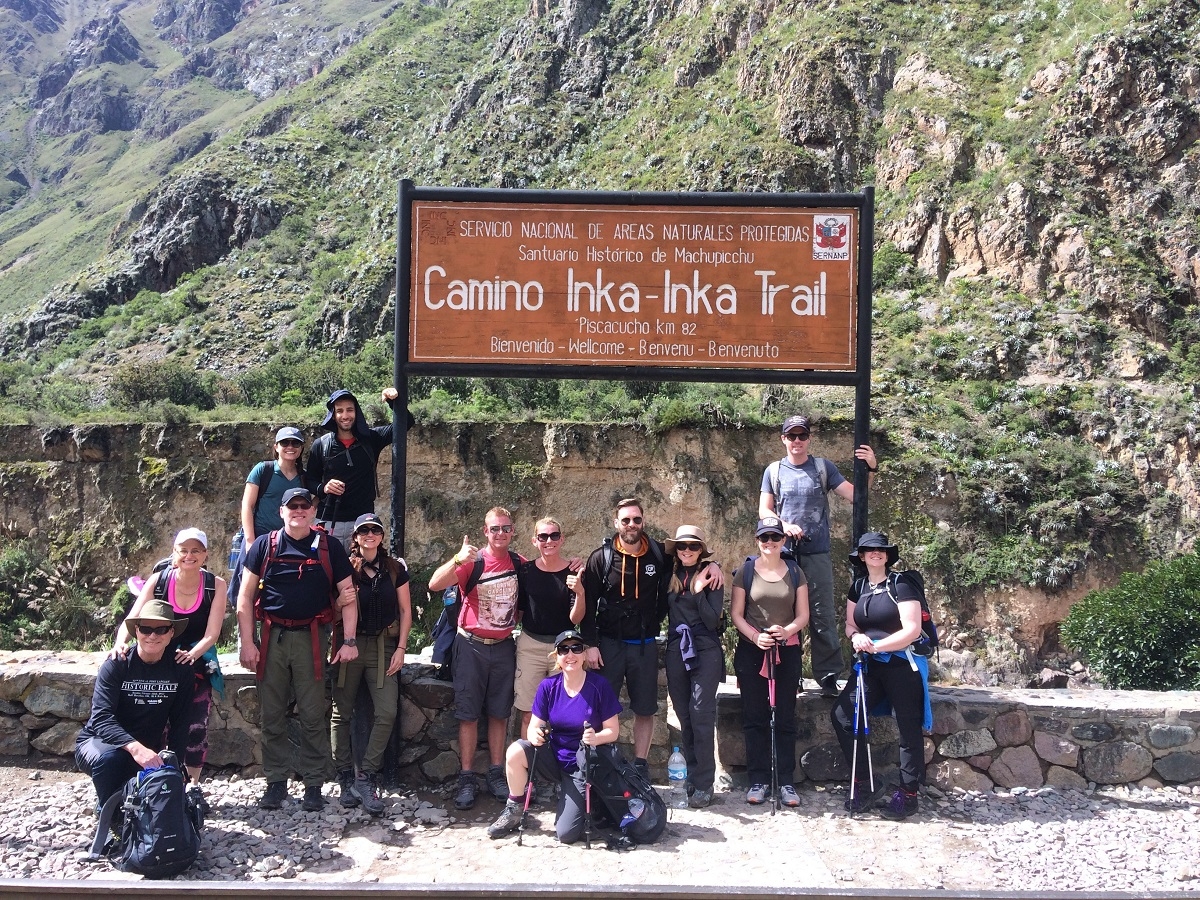
Our group, about to head off on the Inca Trail to Machu Picchu
While we waited to get our passes checked we could see lines of identically-dressed porters, laden with tents and bags, set off at breakneck speed up the path.
Every day they would pitch our tents ahead of our arrival and pack up once we’d gone, serve breakfast, lunch and dinner and shoot past us on the trail to rebuild camp once again.
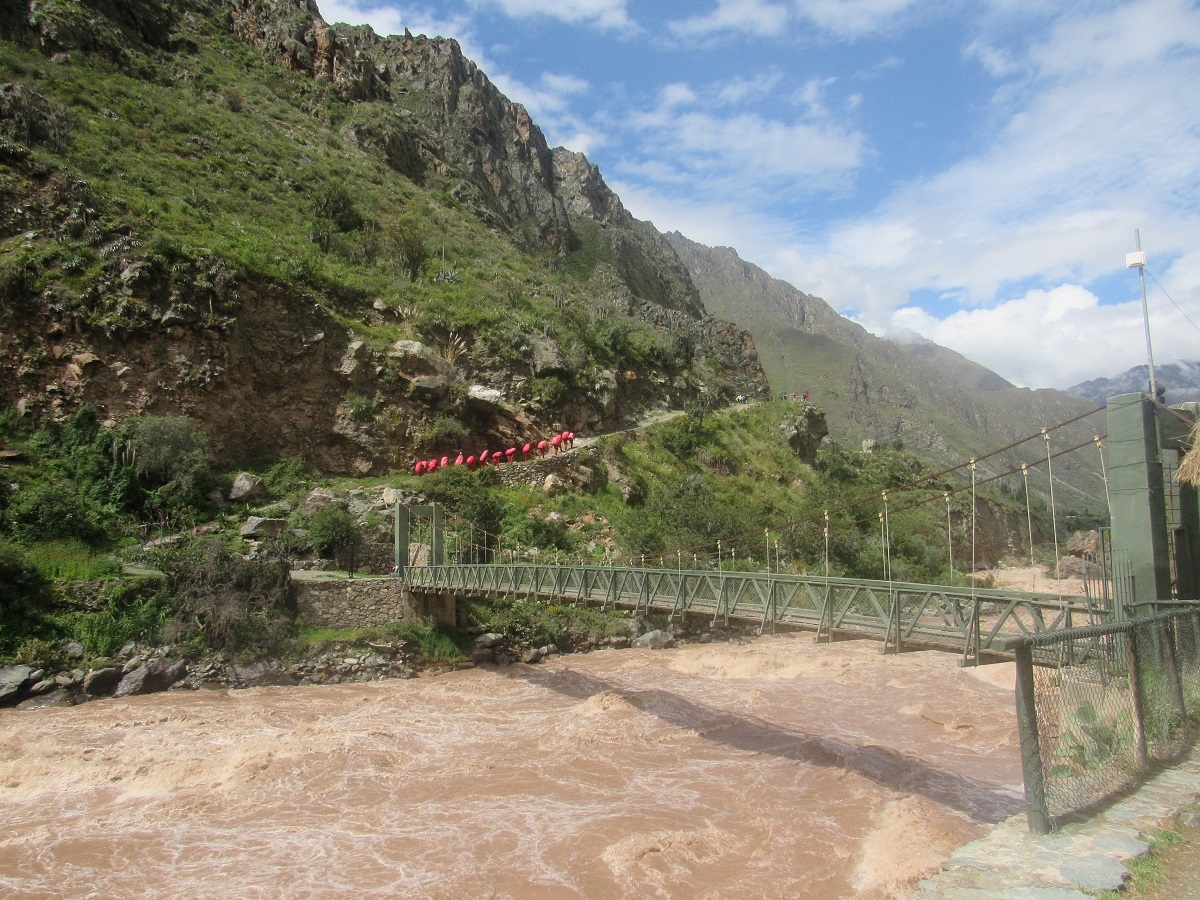
As we approached the checkpoint we could see the first teams of porters dash up the path, laden with bags. This guys carried not only our bags but all the tents and food for the journey and work incredibly hard
We had it far easier with just our day sacks (although they were pretty heavy due to the two litres of water we were each carrying) and thankfully the start of the trail was nice and easygoing, like a walk through a beautiful botanical gardens.
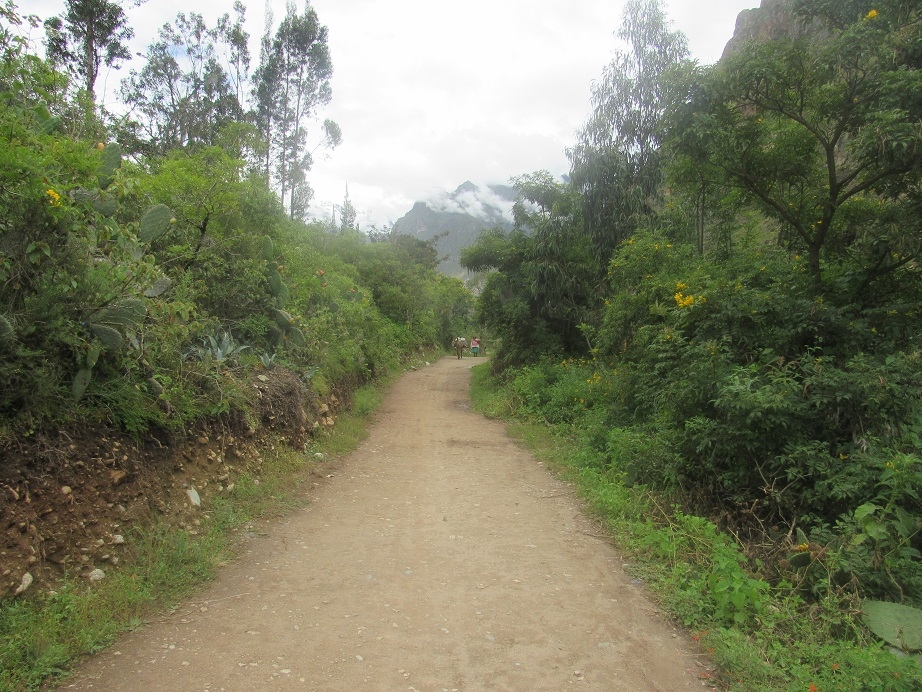
The start of the Inca Trail was flat and pleasant, like a Sunday stroll through a country park
Elias pointed out interesting plants and trees as we ambled along, and at one point stopped us to daub red beetle juice on our faces, like an initiation ceremony. ‘Now you are all Super Condors!’ he exclaimed dramatically and it certainly helped make us feel like a proper team.
The Inca Trail gets steeper
We would need all the support we could get later on, when the path took a couple of sharp turns upwards and the combination of altitude and the steep stone steps of the path meant we got out of breath really quickly. The path was soon far above the rushing waters of the river below and the surrounding mountain forest made for excellent views (and taking photos was a great excuse to catch your breath).
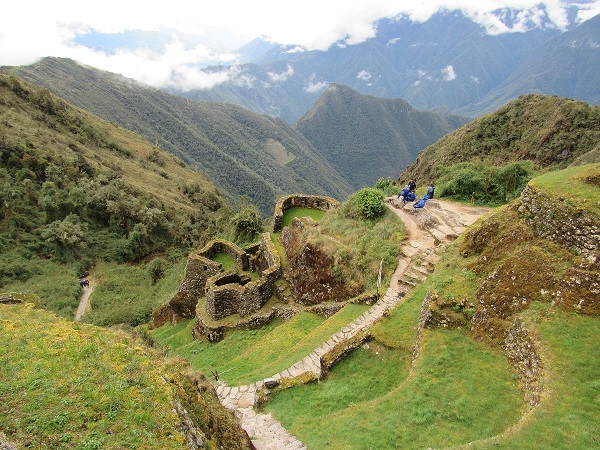
The scenery quickly became more dramatic as the path headed up into the hills
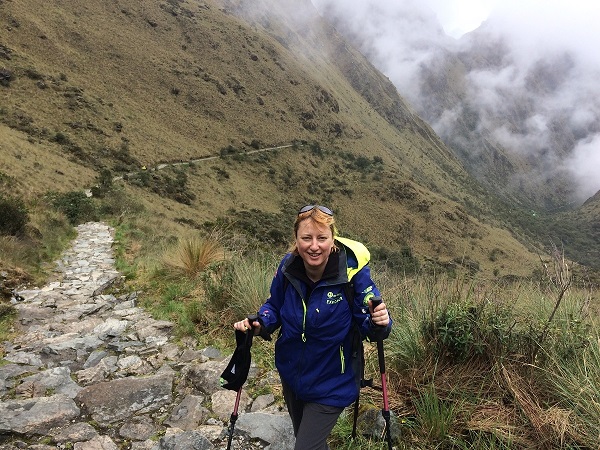
A much-needed chance to stop and catch my breath (disguised as a photo op)
Inca Trail toilets
Apart from the porters dashing past – the cry ‘Porters!’ would come up from the back and we’d press ourselves into the mountainside – we had the trail pretty much to ourselves, only occasionally passing or being passed by other trekkers and sometimes crossing women with donkeys coming down from the pass.
These women would sell water, food and even alcohol at various points on the trail, and on the first day at least there were plenty of loos for walkers too – at picnic spots or little huts on the side of the path costing 1 sol (20p). Deeper into the trail it was more a case of using ‘nature’s toilet’ and indeed there were times when it was preferable to go outdoors than in, considering the state of the loos later on.
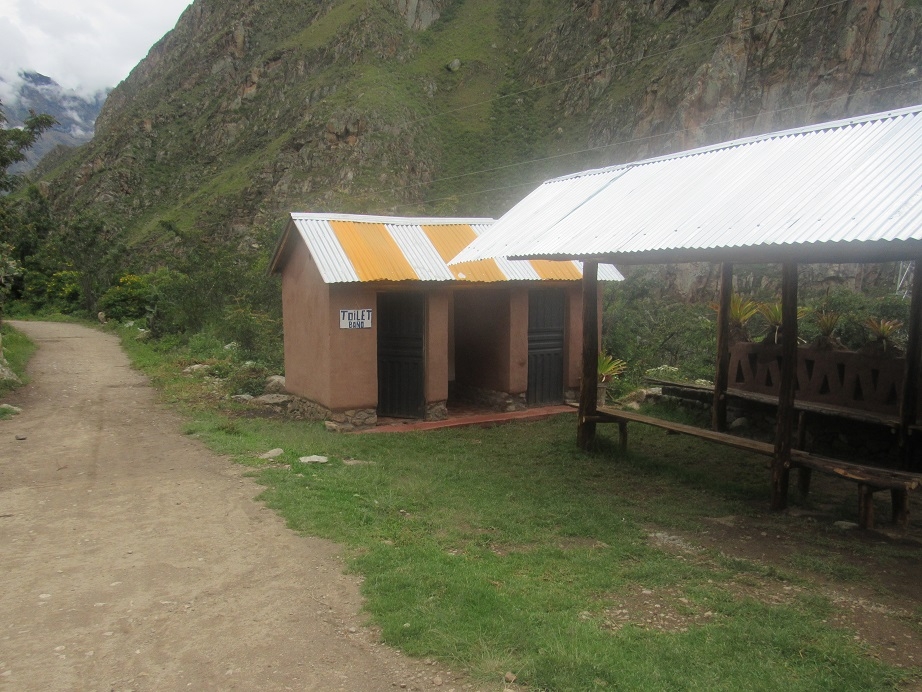
For the first day and a half on the Inca Trail, there were loads of handy little loo stops on the path, costing one sol (20p). Later on there were fewer loos and you were best off using ‘nature’s toilet’
Meals on the Inca Trail
However we weren’t exactly roughing it, as meals each day was served in a proper dining tent, with long benches and a variety of dishes passed along each side: soup, and salad, little wraps, plates of rice, stews, beans, chicken: the plates were plentiful and tasty and quite impressive considering they were whipped up on the move.
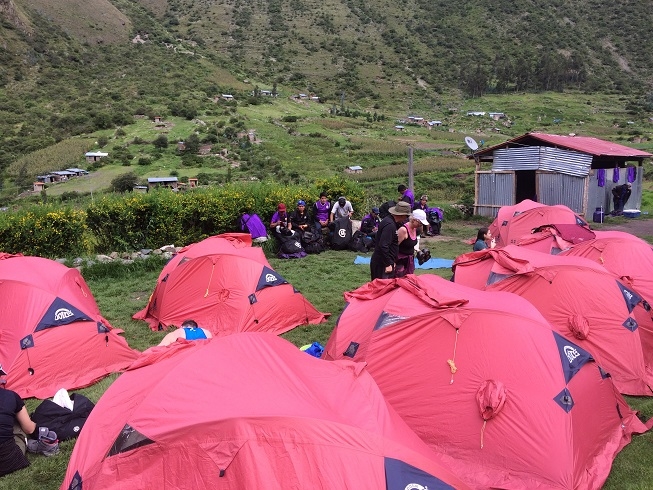
A welcome sight at the end of the first day: our tents, already pitched, in a field at the end of a beautiful valley
Reaching the campsite on the first afternoon was a relief for sore legs, and even better to realise that our tents were already pitched and there was cold beer to buy.
We toasted our efforts under the blue sky with mountains all around, and after a hearty dinner and several card games, we were under canvas and asleep by 9pm.
The next morning I awoke to the clatter of rain on my tent and it was a rather damp group that set off after breakfast, nervous about the day ahead.
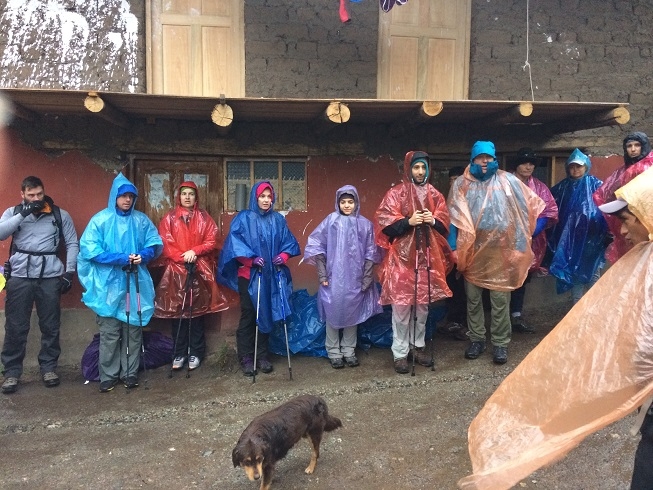
‘This is supposed to fun, right guys?’ The rather soggy start to the second (and steepest) day’s hiking
Inca Trail gets steeper
Thankfully the rain soon stopped but the steep path was relentless and we soon split into smaller groups as some powered on up and others took a more leisurely approach.
Much to my surprise, while it was hard-going (and I wished I’d put some hours on the stepping machine at the gym) I started to love the exertion, the physical and mental effort required just to keep going, the beautiful scenery all around and the feeling that I was doing something totally different to my working days stuck in front of a laptop.
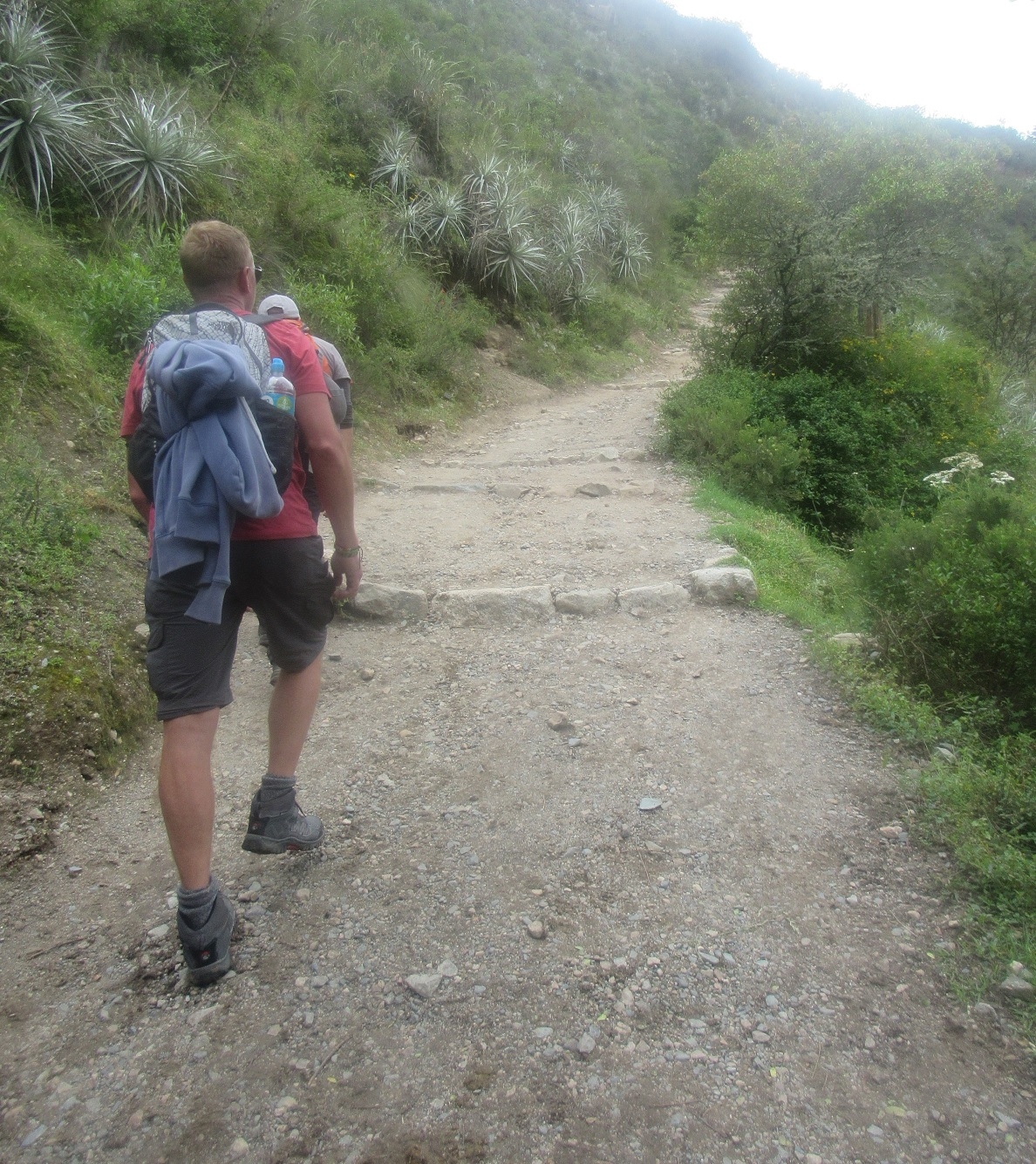
The path was relentlessly uphill, but some bits were gentler than others. Thankfully we could all go at our own pace and soak up the views on the way
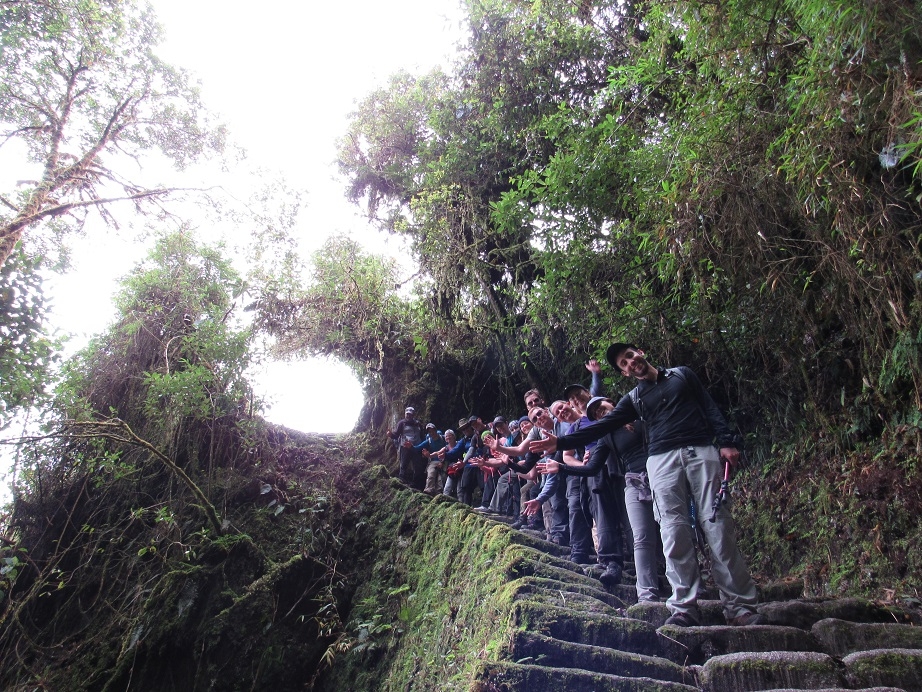
We were all very cheerful at this point – probably because the steps were going down for a change
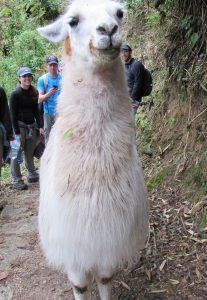
Meeting a fellow traveller on the Inca Trail
One super-fit guy up ahead kept on shouting back in encouragement ‘Not long to go now!’ but while I was exhausted, I didn’t want it to end.
This feeling stayed with me throughout the trip (in spite of the aching legs, early starts and the frankly terrible toilets nearer the end of the trail) and I grew to love the epic ups and leg-trembling downs just as much as the joy of sharing life stories with total strangers who became great friends, and the sheer relief of taking hiking boots off at the end of another day.
Altitude sickness on this Machu Picchu holiday
Healthwise we all seemed to be doing pretty well, with just a few blisters (mainly from people who were wearing trainers rather than walking boots) and the occasional bout of altitude sickness.
I chose to take altitude sickness tablets in advance and was glad I had done, as the only symptoms I had was bouts of severe tingling at the end of my fingers, as if they were loaded with fireworks which were about to go off.
One guy in our group felt very ill at Dead Woman’s Pass but recovered once he dropped down into the valley, and one woman we met who had been sick on the trail also felt fine once she lost height.
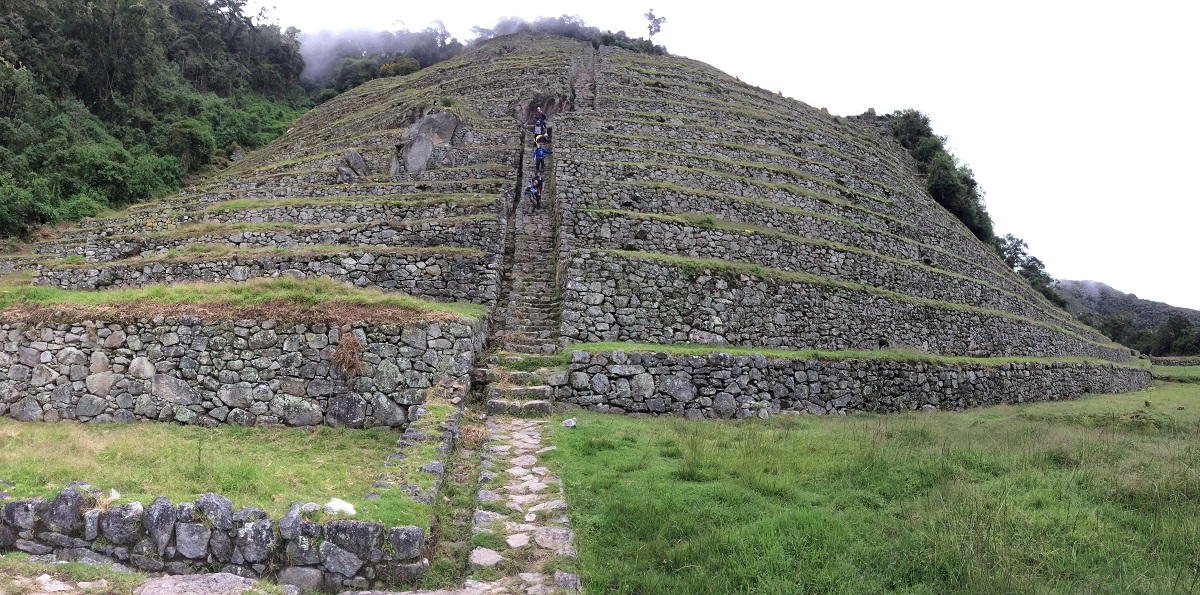
This looks tiny but was actually a vast Inca terrace, built high up in the mountains just around the corner from Machu Picchu
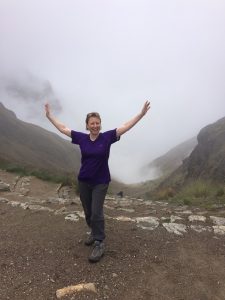
I was pretty excited to reach the top of Dead Woman’s Pass, as you can tell… (probably due to the fact I could take my rucksack off for a few minutes)
Dead Woman’s Pass
The second night was spent at the bottom of the valley just below Dead Woman’s Pass (Elias was right – we had a late lunch and then spent the afternoon chatting and chilling).
The third day was the most beautiful of the lot, scenery-wise, as the undulating path wound its way through lush green forests, overlooking some spectacular views and with the chance to visit some Inca ruins. We were even awarded a cake for our efforts!
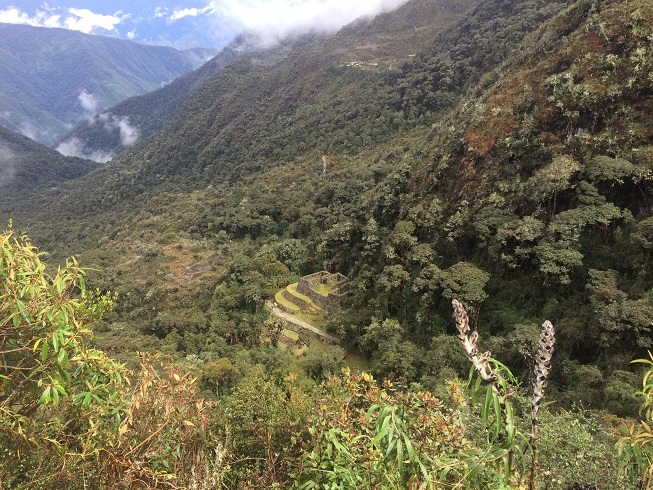
The scenery changed constantly and you’d never know quite what you’d spy from the path…

Our cake! We felt like we’d earned it (and were in awe of the team for making this in tents in the middle of the Inca Trail)
Our final night on the trail was short (with that 3am start) but we probably wouldn’t have been able to sleep much anyway, being hyper-aware that Machu Picchu was just the other side of the mountain.
The final night of my Machu Picchu holiday
The campsite on the final night was the most basic of the lot – just a couple of row of tents on gravel, truly awful loos a long trek away and not much in the way of local foliage.
I finally plucked up the courage to use my TravelJohn portable loo-bag (sounds hideous but frankly a much better option than using those final loos) and after a quick bite to eat, we trekked in the pitch dark to wait at the make-shift bus shelter for two hours before the checkpoint opened.
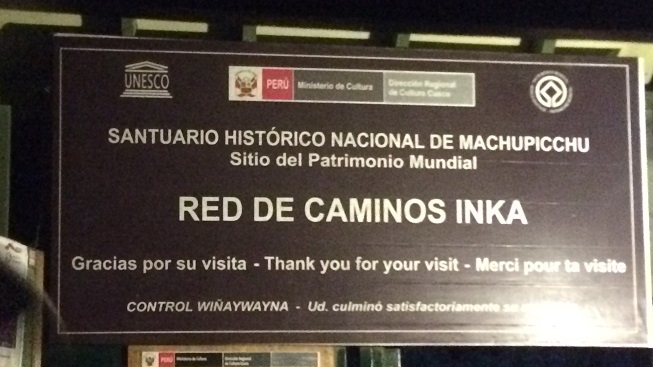
Waiting in the dark to go through the final checkpoint on the Inca Trail
While I’m not great on early starts and sitting on the floor for hours in the dark, it was actually really lovely and a really memorable part of the trip for me – I was wearing practically all my clothes to ward off the cold and was so cosy and tired that I fell asleep in the middle of the chatter of hundreds of people around me. Suddenly the word went round – it was time to go!
‘People get over-excited and started running the moment they go through the checkpoint,’ Elias had warned the night before. ‘Remember, it’s been there for 500 years and will still be there wherever you get there. There’s no need to run.’
Reaching Machu Picchu
With a two-hour hike still to climb, we weren’t running but were certainly trekking at a faster than usual pace. Everyone was rather quiet, due to the early hour or just lost in thought as we neared our destination, and we only stopped once to shed layers as the sun rose and the air became warmer.
There was one final, vertical ascent up a stretch known as the ‘monkey steps’ which you climbed using your hands as well as your feet – and then we were there, at the Sun Gate, looking down onto one of the most famous views in the world. It was elating, it was awe-inspiring and it was worth every step.
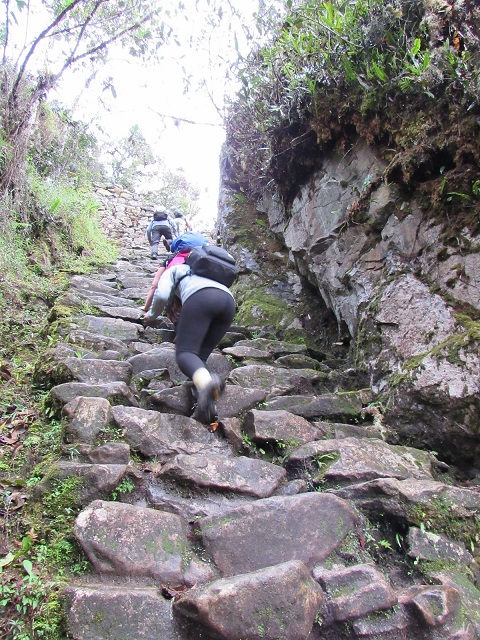
The Monkey Steps were the steepest part of the Inca Trail (and were thankfully pretty short). Our guide Elias sprinted up! (the rest of us didn’t)
By getting there under our own steam we felt we’d really earned the right to be there, and as we walked along the path which skirted along the mountainside towards Machu Picchu itself, making us feel like we were walking on the edge of the world, we couldn’t take our eyes off it, as if it was was going to disappear any moment.
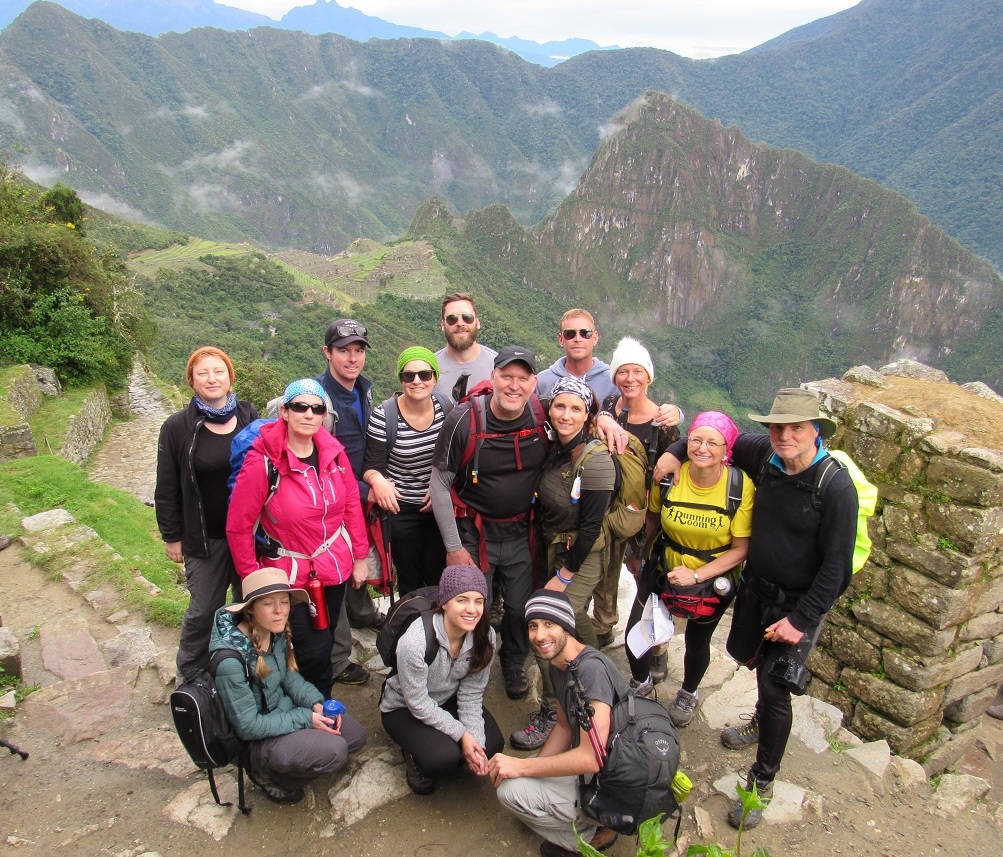
We made it! A very happy band of travellers at Sun Gate with Machu Picchu behind us (on the left, next to the peak)
At luck would have it, the moment we arrived at the top of the site, source of a million photos, Machu Picchu did suddenly disappear – hidden by a thick blanket of white clouds, sending the day-trippers into a panic as they tried to take selfies in the white-out.
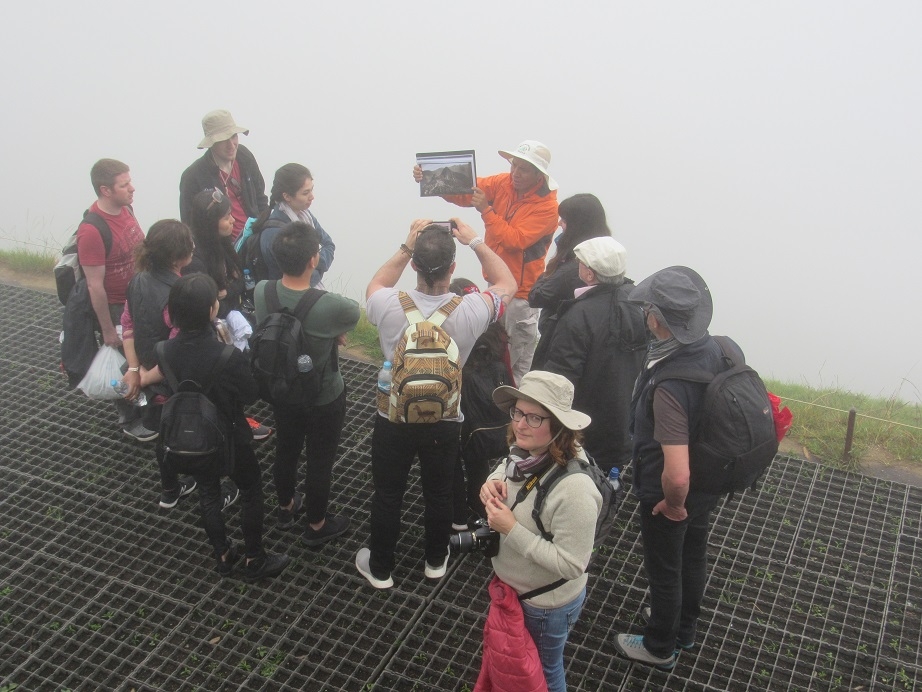
‘So here’s a picture of what you would be able to see if there wasn’t this massive white cloud in the way…’
To us, it didn’t matter one bit. It was strange enough being around other people for a change (we had to remind ourselves that this wasn’t the place to use ‘nature’s toilet’ – just four days away from civilisation had had that effect on us) and we just wanted to soak up the atmosphere (of course, we shot back up the hill for pictures when the clouds finally lifted).
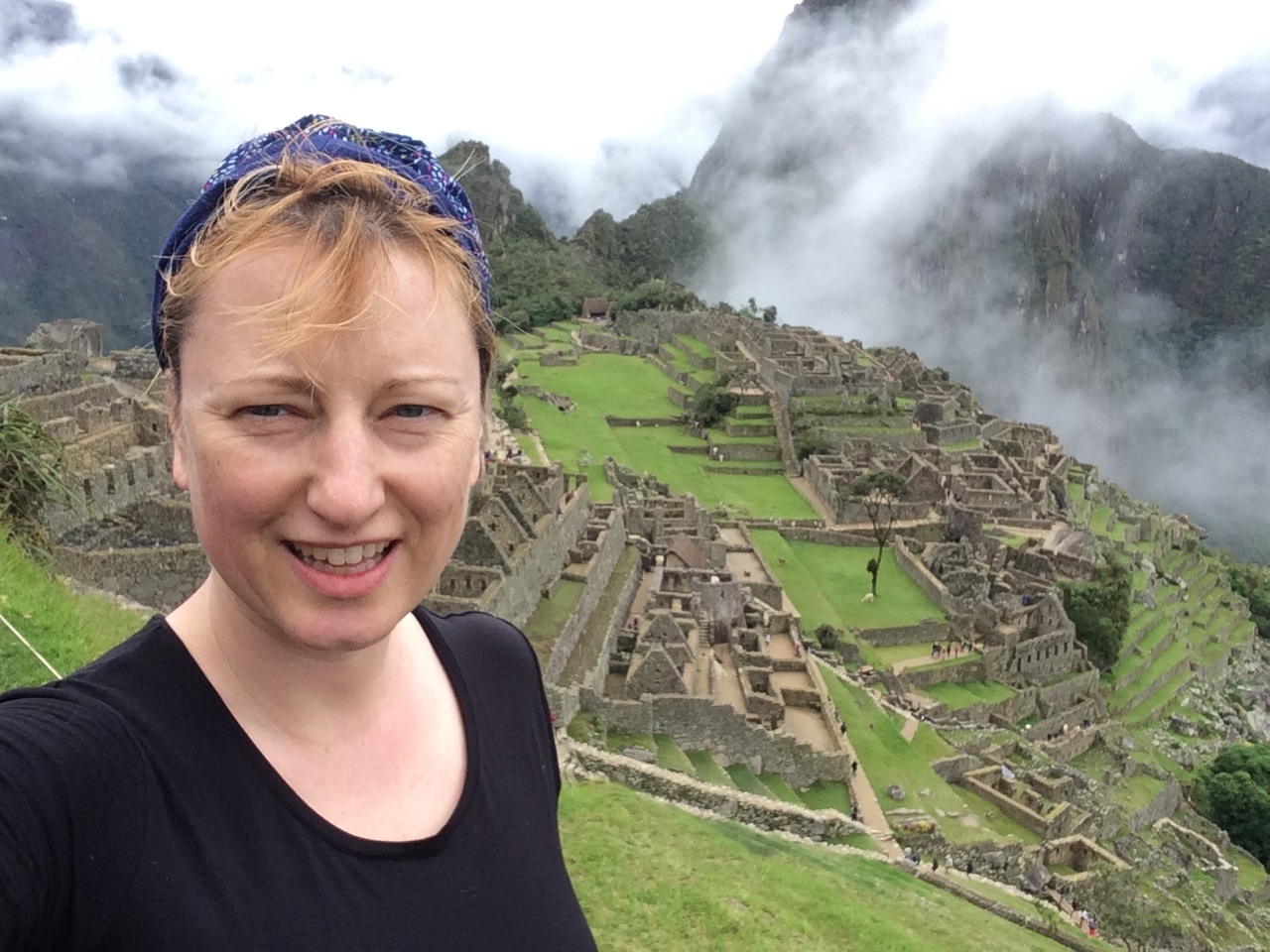
The obligatory selfie, once the clouds had lifted
Exploring Machu Picchu
Perched on a rock, Elias told us about the history of the place and how it has been restored and renovated to give an idea of what it was originally like, and then we joined the llamas and other tourists wandering around the site for the morning, taking pictures, having our passports stamped and taking great delight in the first clean loos for days.
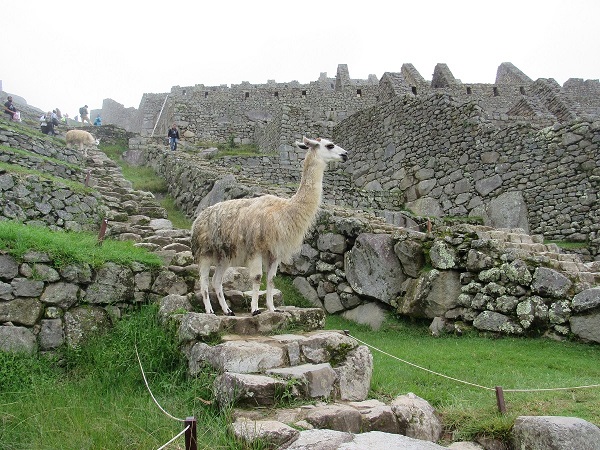
A llama makes himself at home in Machu Picchu
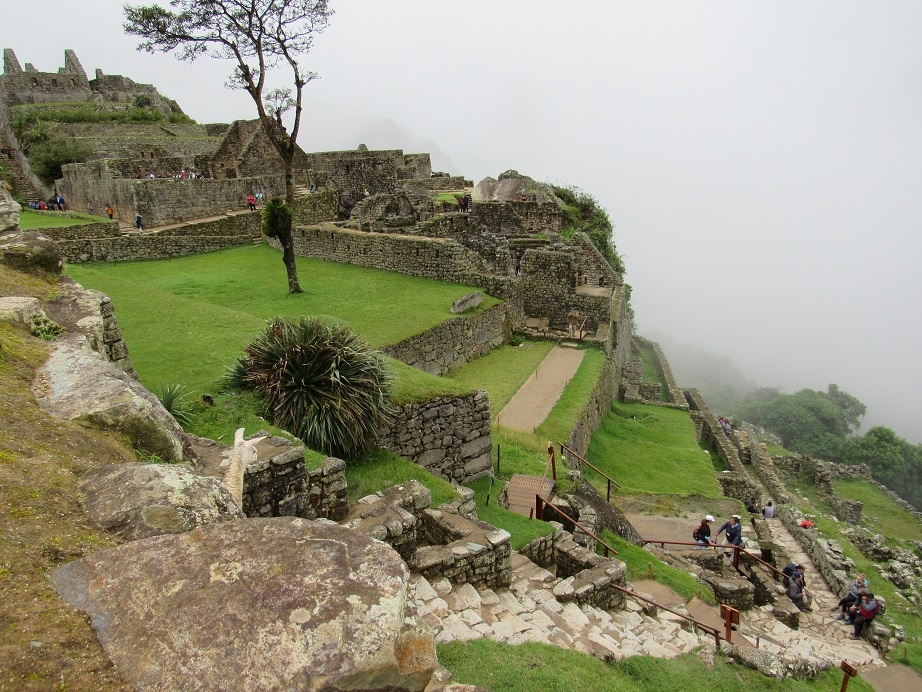
It was great to spend the morning exploring Machu Picchu at our own (very slow by now) pace
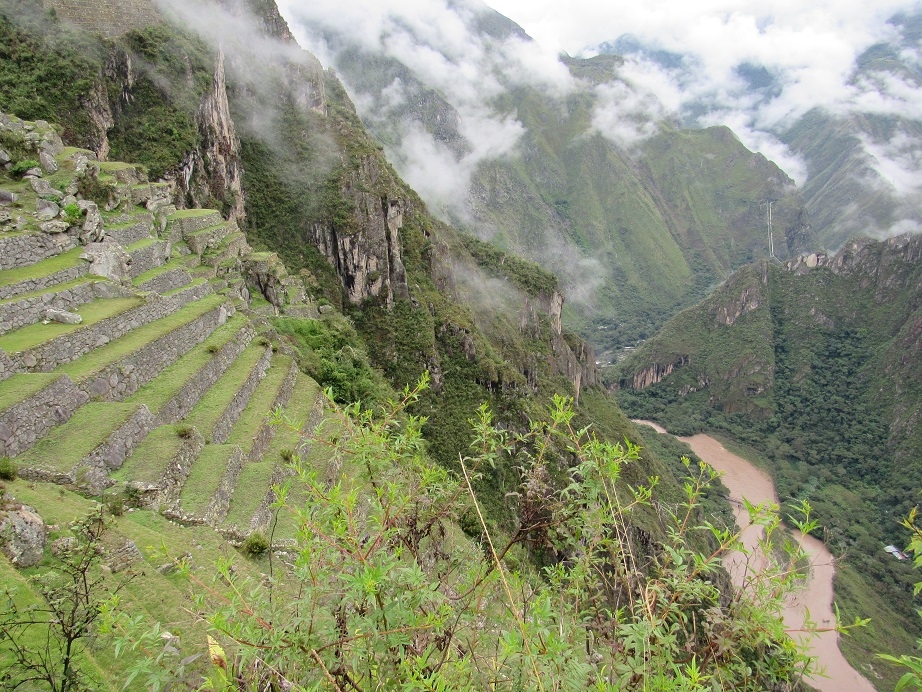
The lower parts of Machu Picchu seem on the verge of plunging into the valley far below
The road to Aguas Calientes
Astonishing though the place is, it was only when we boarded one of the buses to Aguas Calientes, the town at the bottom of the mountain, that it really sunk in what an amazing location it was in.
The mountain is so tall that you can’t even glimpse the summit at the bottom and it’s small wonder that Machu Picchu remained hidden for so long. Even the steep hair pin road going up to Machu Picchu felt like a seriously impressive architectural achievement.
The bustle and traffic of Aguas Calientes was a world away from the calm of the Inca Trail and the train and bus journey back passed in a blur of noises and images.
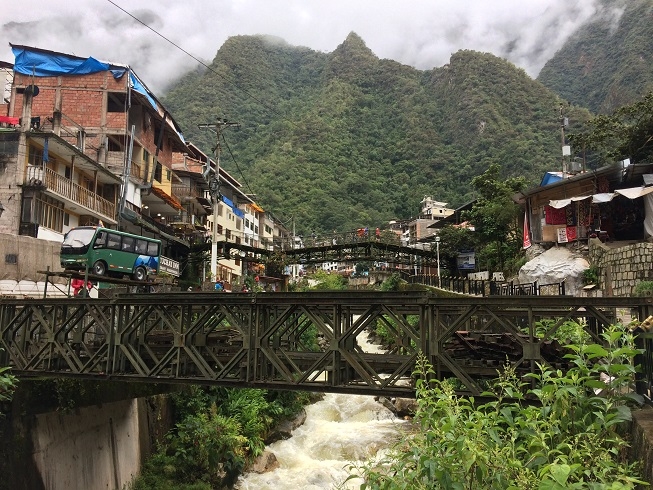
Aguas Calientes was a blur of noise and smells and crazy sights and a world away from the calmness of the Inca Trail
Back in my hotel room for one final night before flying home, it almost felt like a dream – but what an amazing one. And much to my surprise, while Machu Picchu is an awe-inspiring place, it is the memory of the Inca Trail which will last the longest.
If you like reading about some amazing destinations then check out these other reviews from ALadyofLeisure: A holiday of a lifetime learning to dive in the Cayman Islands; River-rafting and zip-lining, boat trips and beach cocktails, my perfect Jamaica holiday; My epic food tour of Japan: sushi, sake, puffer fish and bullet trains; Volcanoes and fire-dancing: just a typical day exploring Papua New Guinea; My action-packed holiday in Mauritius; Exploring Montenegro and the stunning Bay of Kotor; Visiting the Seventh Continent in a 15-day cruise to Antarctica